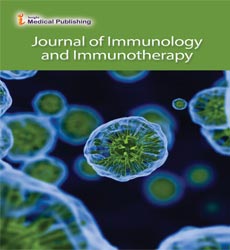Specific Immune Components in Host Defense
Oliver Caruso*
Editorial office, Journal of Immunology and Immunotherapy, United Kingdom
- *Corresponding Author:
- Oliver Caruso Editorial office, Journal of Immunology and Immunotherapy, United Kingdom. E-mail: jmso@emedicinejournals.org
Received Date: June 02, 2021; Accepted Date: June 05, 2021; Published Date: June 14, 2021
Citation: Caruso O (2021) Specific Immune Components in Host Defense. J Immuno Immnother Vol.5 No.3:11.
Editorial Note
Invading microbial infections are quickly caught in the nearest specialized organ, known as lymph nodes, where required immune responses to remove the bacteria emerge. The virus travels to the lymph nodes via a network of channels known as the lymphatic system. Microbial pathogens are swallowed by phagocytic or similar kinds of cells known as Antigen Presentation Cells (APCs) in these organs, and their component is digested and delivered by these cells to T cells to produce appropriate immune responses. Another cell type, B cells, produces a wide variety of chemicals that attach to the surfaces of microorganisms known as antibody and then inactivate the pathogen. T cells can develop into numerous functional subtypes based on the pathogen to produce pathogen-specific immune responses. These cells, in addition to microbial pathogens, play an essential role in immunological homeostasis. Dysregulated B and T cells can also lead to an immunological disaster, which can lead to the development of cancer or autoimmune disorders.
Inflammation is a necessary defensive reaction to infection; but, too much inflammation may be harmful and cause collateral damage to the host. It is also linked to non-infectious illnesses such as cancer, autoimmune diseases, and transplant rejection. Inflammation can cause the development of new lymphoid tissue aggregates known as Ectopic Lymphoid-Like Structures (ELS) or tertiary lymphoid organs, which are made up of different professional immune cells such as B and T cells.
Immunological cell and soluble mediatior dynamics are critical for host defense and immune homeostasis. It is mediated by immune cell trafficking, which is mediated by complicated signaling networks. Immune cell mobility is largely supported by cell surface components such as leukocyte adhesion molecules, integrin, lectins, tetraspanines, and/or the activation of chemokines and chemokine receptors, among others. Semaphorin 4D (Sema 4D), a protein from the semaphorin family, is thought to have a key role in axon guidance and immunity, particularly cell migration.
Protein post-translational modification is critical for maintaining protein structure and biological activity. Several proteins, including receptors, ligands, immunoglobulins, and others, are glycosylated. Immunoglobulin, for example, is highly glycosylate, and this glycosylation is required for biological activity.
The mammalian host can generate a wide range of antibodies against a wide range of biotic and abiotic organisms. The production of various antibodies from a restricted genome was a difficult task addressed by the tireless efforts of numerous immunologists, especially Susumu Tonegawa, whose work won the coveted Nobel Prize in 1987 for revealing the molecular foundation of antibody variety. B cells initially generate low affinity antibodies against antigens and have a limited function in infection clearance. To successfully remove the invading pathogen, B cells undertake the processes known as Somatic Hyper Mutation (SHM) and Class Switching Recombination (CSR).
T Helper (Th) cells, also known as CD4+T cells, are master controllers of adaptive or pathogen-specific immunity. Th cells shape adaptive immunity by developing into numerous functional subtypes such as Th1, Th2, Th17, Th9, and Treg cells. These cell types not only stimulate immunity, but they also depress adaptive immunity and cause dysregulation in these cells, which can lead to oncogenesis or autoimmune illness.
Open Access Journals
- Aquaculture & Veterinary Science
- Chemistry & Chemical Sciences
- Clinical Sciences
- Engineering
- General Science
- Genetics & Molecular Biology
- Health Care & Nursing
- Immunology & Microbiology
- Materials Science
- Mathematics & Physics
- Medical Sciences
- Neurology & Psychiatry
- Oncology & Cancer Science
- Pharmaceutical Sciences
